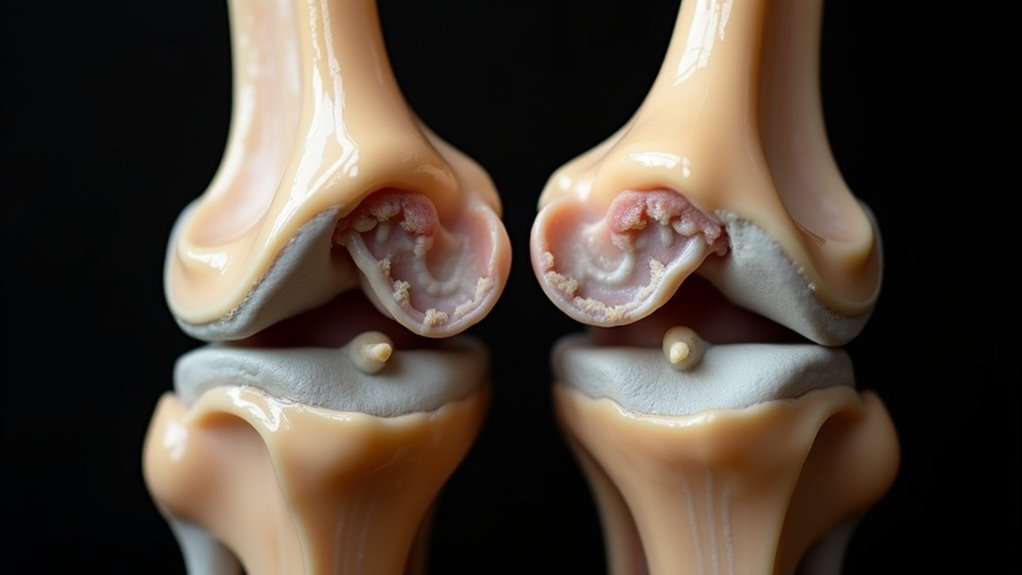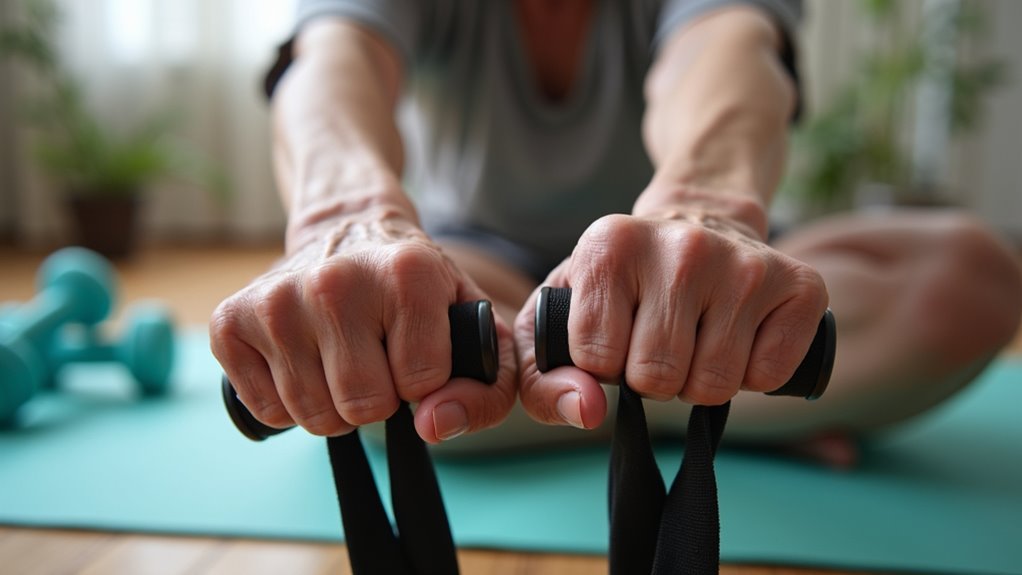Leading causes of osteoarthritis include maturation, excess weight, genetic predisposition, and previous joint injuries. You’re at higher risk after midlife, with over 80% of adults showing signs by middle age. You can protect your joints by maintaining a healthy weight, as each pound lost reduces knee stress by four pounds. Regular physical activity and early injury treatment also help prevent cartilage breakdown. Understanding these factors will equip you with powerful strategies for long-term joint protection.
Understanding the Basics of Joint Degeneration

How does a healthy joint deteriorate into one affected by osteoarthritis? Your joints undergo natural wear and tear throughout your lifetime, but certain factors can accelerate this process. When your cartilage begins to break down, it leads to increased friction between the bones in your joints.
The deterioration isn’t limited to cartilage alone. As your joint structure weakens, it affects surrounding tissues, bone surfaces, and the protective joint lining. While aging is a primary factor in this degeneration, you’re at higher risk if you’ve experienced joint injuries, carry excess weight, or have specific medical conditions that impact joint health.
Understanding this progression is vital because joint degeneration varies extensively among individuals. While you can’t completely halt this natural process, recognizing these fundamental changes helps you take preventive measures to protect your joints.
Primary Risk Factors and Their Impact

Your risk of developing osteoarthritis increases with maturity due to natural cartilage degeneration and reduced joint repair capacity. If you’re carrying excess weight, you’re putting excessively more stress on your weight-bearing joints, particularly your knees, which accelerates joint deterioration. Your genetic makeup can also influence your susceptibility to osteoarthritis, with specific inherited gene variants affecting joint structure and function.
Age and Joint Degeneration
As people mature, their joints undergo natural degenerative changes that markedly increase the risk of developing osteoarthritis, particularly after midlife.
Your risk of joint degeneration rises substantially after lifespan 45, with more than 80% of adults over decade 55 showing evidence of osteoarthritic changes. The primary mechanism involves the gradual wear and tear of cartilage that normally cushions your bones’ ends within joints. As this protective tissue breaks down, you’ll experience increased bone-on-bone contact, leading to pain, stiffness, and decreased joint stability.
While you can’t control genetic factors or previous joint injuries that may accelerate this process, you can take preventive measures. Maintaining a healthy weight and engaging in regular physical activity will help preserve your joint function and potentially slow the lifetime-related degeneration of your cartilage.
Weight’s Effect on Joints
Body weight plays a pivotal role in determining your risk of developing osteoarthritis, particularly in weight-bearing joints. If you’re carrying excess weight, you’re placing your knees and hips under significant stress, making you 2.5 times more likely to develop knee osteoarthritis compared to maintaining a healthy weight.
The relationship between weight and joint health is striking: for every pound you lose, you’ll reduce the load on your knee joints by four pounds. Even modest weight loss can make a substantial difference shedding just 10% of your body weight can improve both pain levels and physical function if you’re already experiencing osteoarthritis symptoms. To protect your joints, maintaining a healthy body weight through proper diet and regular exercise remains one of your most effective strategies for preventing and managing this condition.
Genetic Predisposition Factors
Genetic factors contribute to approximately 60% of osteoarthritis risk, making heredity one of the strongest predictors for developing this joint condition. If you have a parent or sibling with osteoarthritis, you’re at higher risk due to shared genetic predisposition. Your genetic makeup can affect joint structure and collagen production, potentially increasing your susceptibility to cartilage breakdown.
| Genetic Factor | Impact | Risk Level |
|---|---|---|
| Family History | Direct relatives with OA | High |
| Gene Mutations | Cartilage degeneration | Moderate-High |
| Collagen Variants | Altered joint structure | Moderate |
| DNA Expression | Inflammatory response | Variable |
While you can’t change your genetic makeup, understanding your family history helps you and your healthcare provider develop preventive strategies. Early awareness of genetic risk factors enables proactive joint protection through lifestyle modifications and preventive care.
The Role of Age and Genetics

Your maturity and genetic makeup represent two significant factors in osteoarthritis development, with your risk increasing substantially after maturity. If you have a family history of osteoarthritis, you’re carrying approximately 50% higher risk, particularly for specific joint locations including hands, knees, and hips. You can’t control these inherent risk factors, but understanding your genetic predisposition and age-related risks enables you to work proactively with healthcare providers to implement preventive strategies.
Natural Aging Process
Two key factors drive the development of osteoarthritis: years-related changes and genetic predisposition. As you mature, your cartilage naturally undergoes wear and tear, with over 80% of adults above 55 experiencing some degree of joint deterioration. This gradual breakdown occurs as the protective cushioning between your bones diminishes, leading to increased friction and compromised joint function.
Your natural aging process affects how your body maintains and repairs cartilage tissue. When your joints lose this crucial protection, you’ll likely experience stiffness, pain, and reduced mobility as bones begin to rub against each other. While you can’t stop the aging process, understanding this process helps explain why osteoarthritis becomes more prevalent in older populations. Women face a higher risk due to hormonal fluctuations and anatomical differences that can accelerate joint deterioration.
Family Medical History
Family history serves as a pivotal predictor of osteoarthritis risk, particularly when combined with maturity-related factors. Your genetics play a vital role in determining susceptibility to joint deterioration, especially if you have a family member who’s been diagnosed with osteoarthritis. Inherited joint abnormalities and genetic predispositions can accelerate the onset of this condition.
- If your parents have osteoarthritis, you’re more likely to develop joint problems earlier in life
- Your inherited joint structure may make you more vulnerable to cartilage breakdown
- Having a family history of rheumatoid arthritis increases your risk of secondary osteoarthritis
- Genetic factors can influence how your body responds to joint stress and inflammation
- Your inherited bone density and joint alignment patterns may affect disease progression
Understanding your family medical history enables proactive preventive measures and earlier interventions when necessary.
Weight Management for Joint Protection
Maintaining a healthy weight stands as one of the most effective strategies for protecting your joints against osteoarthritis. Your body mass index directly impacts the stress placed on weight-bearing joints, and excess pounds can accelerate joint deterioration.
You’ll experience significant benefits by losing just 5-10% of your total body weight, including reduced pain and improved physical function. To achieve these results, you’ll need a structured approach that combines proper nutrition and appropriate exercise. Work with a healthcare provider or registered dietitian to develop a personalized weight loss plan that considers your joint health. Choose low-impact activities like swimming or cycling to support your weight management goals while minimizing joint stress. Regular monitoring of your progress and making sustainable lifestyle adjustments will help you maintain a healthy weight for ideal joint protection.
Physical Activity and Joint Health
Beyond weight management, regular physical activity serves as a cornerstone in preventing osteoarthritis and promoting joint health. When you engage in targeted exercises, you’ll strengthen joints and supporting muscles, substantially reducing your risk of joint pain and cartilage deterioration. Working with a physical therapist can help you develop an exercise routine customized to your specific needs.
- Feel empowered as you maintain independence through improved joint mobility
- Experience the freedom of movement with low-impact activities like swimming
- Build confidence as you strengthen the muscles protecting your joints
- Take control of your joint health through personalized exercise programs
- Preserve your quality of life by maintaining range-of-motion
Focus on low-impact exercises that strengthen without straining your joints. Regular physical activity does not just safeguard your joints but also boosts overall joint function and mobility.
Common Injuries That Lead to Osteoarthritis
While many factors contribute to osteoarthritis development, specific joint injuries substantially increase your risk of developing this degenerative condition. ACL tears and ankle sprains can trigger long-term joint deterioration, while repetitive stress from sports or occupational activities gradually wears down your protective cartilage.
Traumatic injuries, particularly knee and hip fractures, disrupt your joint’s natural structure and mechanics, often leading to post-traumatic osteoarthritis. You’re especially vulnerable when damage occurs to critical components like your knee’s meniscus, which serves as a crucial shock absorber. Correspondingly, joint dislocations and ligament tears, whether in your shoulder or ankle, can permanently alter joint stability. These injuries create abnormal movement patterns that accelerate cartilage breakdown and increase your likelihood of developing osteoarthritis in the affected joints over time.
Early Warning Signs to Watch For
Since osteoarthritis develops gradually, recognizing its early warning signs can help you seek timely intervention. Joint stiffness and persistent discomfort that lasts more than several days can signal the onset of this condition. If you’re experiencing pain and stiffness, particularly after periods of inactivity, you may be developing the condition and should consult a healthcare provider.
- Your joints make cracking or grinding sounds during movement, indicating potential cartilage deterioration
- You notice reduced flexibility or limited range of motion in affected joints
- Movement becomes difficult, especially after sitting or lying down for extended periods
- You experience persistent swelling around joints that doesn’t resolve quickly
- Your joints feel unstable or weak during normal daily activities, affecting your balance and coordination
These symptoms warrant prompt medical evaluation to prevent further joint damage and manage symptoms effectively.
Lifestyle Modifications That Make a Difference
Making sustainable lifestyle changes can protect your joints from osteoarthritis through three key interventions. You’ll need to engage in at least 30 minutes of varied physical activity daily while avoiding repetitive stress on individual joints. Maintaining a healthy body weight through proper diet and exercise reduces joint strain, and you’ll benefit from consulting your healthcare provider to develop a personalized, joint-friendly exercise plan.
Stay Active Every Day
Regular physical activity serves as a cornerstone in preventing osteoarthritis and managing joint health. By incorporating low-impact exercises into your daily routine, you’ll strengthen the muscles that support your joints while maintaining mobility. Working with a physical therapist to develop a personal exercise plan guarantees you’re targeting the right muscle groups without risking joint damage.
- Start with gentle walking sessions to build joint strength and flexibility
- Choose joint-friendly activities like swimming or cycling to protect cartilage
- Focus on consistent, moderate exercise rather than intense workouts
- Maintain proper form during strength training to support joint stability
- Adjust your activity level based on how your joints respond
Maintain Healthy Body Weight
A healthy body weight stands as one of the most essential factors in preventing osteoarthritis, particularly in weight-bearing joints like knees and hips. When you carry excess weight, you’re placing unnecessary stress on these joints, notably increasing your risk of developing osteoarthritis over time.
To protect your joints, you’ll want to maintain a BMI within the normal range through sustainable lifestyle changes. This includes adopting a balanced diet and incorporating regular exercise into your daily routine. If you’re currently overweight, it is imperative to lose weight safely under medical supervision. Don’t hesitate to consult your healthcare provider to develop a personalized weight management strategy that aligns with your specific needs. If you’re already experiencing osteoarthritis symptoms, maintaining a healthy body weight becomes even more vital to prevent further joint deterioration.
Watch Your Joint Strain
Several everyday lifestyle modifications can protect your joints from excessive strain and reduce your risk of developing osteoarthritis. Managing joint strain through thoughtful activities and proper exercise techniques can significantly influence your long-term joint health.
- Don’t ignore signs of joint discomfort they’re your body’s warning signals that you’re putting too much strain on your joints
- Choose low-impact exercises like swimming or cycling to reduce the strain while maintaining strength
- Alternate between different types of physical activities to prevent overuse of specific joints
- Take regular breaks during repetitive activities that increase your risk of joint stress
- Consult your healthcare provider to develop a personalized exercise plan that protects your joints while building strength
Remember to combine these joint-protection strategies with regular physical activity and proper body mechanics to maintain ideal joint health.
Natural Methods for Joint Protection
While many individuals focus on medical treatments for joint protection, natural preventive methods can considerably reduce osteoarthritis risk and slow its progression. You’ll find that maintaining a healthy body weight is vital, as excess weight places unnecessary stress on your weight-bearing joints.
For effective joint protection, incorporate low-impact exercises like swimming or cycling into your routine. These activities strengthen the muscles surrounding your joints without causing excessive strain. You can also practice yoga or Tai Chi to improve flexibility and joint stability. When experiencing discomfort, alternate between heat and cold therapy to manage inflammation. Don’t overlook the benefits of supportive devices properly fitted braces and insoles can provide supplementary joint support during daily activities, helping to distribute pressure more evenly and reduce the risk of joint deterioration.
Preventive Strategies for Long-term Joint Health
Building on these protective measures, extensive long-term joint health requires a systematic approach to prevention. You’ll need to maintain a healthy body weight and engage in regular physical activities that bolster joint function. By implementing evidence-based strategies and working with healthcare providers, you can drastically reduce your risk of developing osteoarthritis.
Regular exercise, weight management, and medical guidance form the cornerstones of preventing joint deterioration and maintaining long-term mobility.
- Monitor your weight closely, as excess pounds directly impact joint stress and inflammation
- Incorporate low-impact exercises to strengthen muscles and improve flexibility
- Keep blood sugar levels stable through proper diet and medication if diabetic
- Practice injury prevention during physical activities with proper form and equipment
- Schedule regular check-ups with healthcare providers to assess your joint health and adjust prevention strategies
These targeted interventions, when consistently applied, create a foundation for sustainable long-term joint health and mobility preservation.
Frequently Asked Questions
What Causes Osteoarthritis and How to Prevent It?
Your risk of osteoarthritis stems from several factors, including joint overuse from repetitive motions and genetics influence that can predispose you to this condition. You can’t change your genes, but you can prevent progression through obesity prevention and maintaining a healthy weight. It’s vital/essential/imperative that you protect your joints during activities, engage in low-impact exercises, and strengthen muscles around your joints to reduce stress on cartilage.
What Is the Exact Cause of Osteoarthritis?
While there’s no single “exact” cause of osteoarthritis, it primarily develops when your joint cartilage breaks down over time. You’re more likely to develop this condition if you’ve had a previous joint injury, carry excessive weight that stresses your joints, or have genetic factors that make you susceptible. The deterioration typically occurs when the natural repair process of your cartilage can’t keep up with the ongoing wear and tear of daily activities.
What Is the Main Cause of Primary Osteoarthritis?
The main cause of primary osteoarthritis is time-related changes that lead to the gradual breakdown of your joint cartilage. As you advance in years, your cartilage naturally degenerates, causing bones to rub against each other. While this wear-and-tear process is primarily linked to maturity, genetic factors can influence how quickly your joints deteriorate. In addition, obesity-related factors can accelerate cartilage damage by placing excessive stress on your weight-bearing joints.
What Is the Primary Prevention of Osteoarthritis?
You can prevent osteoarthritis primarily through key lifestyle modifications. Start by maintaining healthy weight management, as excess pounds greatly stress your joints. Protect your joints by using proper body mechanics during activities and avoiding repetitive movements that cause strain. It is crucial to engage in regular, low-impact exercise to strengthen muscles supporting your joints. In addition, you’ll want to incorporate joint-friendly activities like swimming or cycling into your routine.





